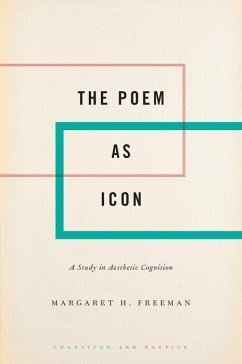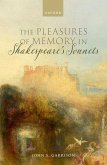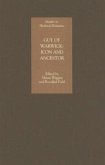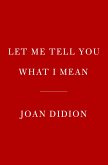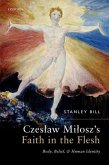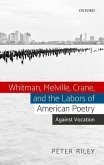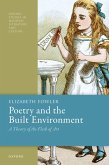- Gebundenes Buch
- Merkliste
- Auf die Merkliste
- Bewerten Bewerten
- Teilen
- Produkt teilen
- Produkterinnerung
- Produkterinnerung
The Poem as Icon resolves long-standing questions of poetic function from a cognitive perspective. Margaret Freeman shows how poetry, as one expression of the aesthetic faculty, enables us to iconically access and experience the "being" of reality.
Andere Kunden interessierten sich auch für
![The Pleasures of Memory in Shakespeare's Sonnets The Pleasures of Memory in Shakespeare's Sonnets]() John S GarrisonThe Pleasures of Memory in Shakespeare's Sonnets102,99 €
John S GarrisonThe Pleasures of Memory in Shakespeare's Sonnets102,99 €![Guy of Warwick: Icon and Ancestor Guy of Warwick: Icon and Ancestor]() Alison Wiggins / Rosalind Field (eds.)Guy of Warwick: Icon and Ancestor138,99 €
Alison Wiggins / Rosalind Field (eds.)Guy of Warwick: Icon and Ancestor138,99 €![Let Me Tell You What I Mean Let Me Tell You What I Mean]() Joan DidionLet Me Tell You What I Mean24,99 €
Joan DidionLet Me Tell You What I Mean24,99 €![Czeslaw Milosz's Faith in the Flesh Czeslaw Milosz's Faith in the Flesh]() Stanley BillCzeslaw Milosz's Faith in the Flesh116,99 €
Stanley BillCzeslaw Milosz's Faith in the Flesh116,99 €![Whitman, Melville, Crane, and the Labors of American Poetry Whitman, Melville, Crane, and the Labors of American Poetry]() Peter RileyWhitman, Melville, Crane, and the Labors of American Poetry110,99 €
Peter RileyWhitman, Melville, Crane, and the Labors of American Poetry110,99 €![Poetry and the Built Environment Poetry and the Built Environment]() Elizabeth FowlerPoetry and the Built Environment122,99 €
Elizabeth FowlerPoetry and the Built Environment122,99 €![The Oxford Handbook of British Poetry, 1660-1800 The Oxford Handbook of British Poetry, 1660-1800]() The Oxford Handbook of British Poetry, 1660-1800204,99 €
The Oxford Handbook of British Poetry, 1660-1800204,99 €-
-
-
The Poem as Icon resolves long-standing questions of poetic function from a cognitive perspective. Margaret Freeman shows how poetry, as one expression of the aesthetic faculty, enables us to iconically access and experience the "being" of reality.
Hinweis: Dieser Artikel kann nur an eine deutsche Lieferadresse ausgeliefert werden.
Hinweis: Dieser Artikel kann nur an eine deutsche Lieferadresse ausgeliefert werden.
Produktdetails
- Produktdetails
- Verlag: Oxford University Press
- Seitenzahl: 228
- Erscheinungstermin: 25. März 2020
- Englisch
- Abmessung: 234mm x 156mm x 14mm
- Gewicht: 490g
- ISBN-13: 9780190080419
- ISBN-10: 0190080418
- Artikelnr.: 58342913
- Herstellerkennzeichnung
- Libri GmbH
- Europaallee 1
- 36244 Bad Hersfeld
- 06621 890
- Verlag: Oxford University Press
- Seitenzahl: 228
- Erscheinungstermin: 25. März 2020
- Englisch
- Abmessung: 234mm x 156mm x 14mm
- Gewicht: 490g
- ISBN-13: 9780190080419
- ISBN-10: 0190080418
- Artikelnr.: 58342913
- Herstellerkennzeichnung
- Libri GmbH
- Europaallee 1
- 36244 Bad Hersfeld
- 06621 890
Margaret H. Freeman is Professor Emerita, Los Angeles Valley College; past president of the Emily Dickinson International Society (1988-1992); co-director of Myrifield Institute for Cognition and the Arts (myrifield.org); and co-editor of the Oxford University Press series Cognition and Poetics. Her research interests include aesthetics, cognitive poetics, linguistics, literature, and philosophy.
Preface
Chapter 1 Poetic Cognition
1. Iconicity and the Being of Reality
2. Toward a Theory of Aesthetic Cognition
3. The Sentience of Cognition
4. Developing a Multidisciplinary Terminology
5. Outline of Chapters
Chapter 2 Icon
1. What Is an Icon?
1.1 The semiotic icon
1.2 The religious icon
1.3 The linguistic icon
1.4 The popular icon
2. The Slippery Slopes of Meaning
2.1 Reification as cognitive economy
2.2 The form-content dichotomy
3. Iconicity in the Arts
4. Iconicity in Literary Criticism
Chapter 3 Semblance
1. Beyond Mimesis
2. Manifestation
3. The In-visibility of Being
4. The Ontology of Poetic Perception as Iconic of Reality
4.1 Prosodic structure
4.2 Prepositional use
4.3 Concealed images
4.4 Sound patterning
Chapter 4 Metaphor
1. Metaphor as Actual World Formation
2. Metaphor as Possible World Formation
3. Metaphor in the Literary Arts
4. The Semeosis of Poetic Metaphor
5. Metaphoring as Cognitive Processing
6. The Hierarchy of Cognitive Metaphoring
7. The Ontology of Poetic Metaphor
8. The Role of Metaphor in Poetic Iconicity
Chapter 5 Schema
1. Probing Sensate Cognition
2. Schema as Correlation Between Self and World
3. Schema as Constraint on Experience
4. The Role of Schema in Imagination and Language
5. Schema as Internalizing Sensate Structure in Poetry
6. PATH and VERTICALITY Schemata in Li Bai's Shudaoan
7. The Poetic Use of Schema
8. Schema as Defining a Poetics
Chapter 6 Affect
1. The Synaesthetics of Affect
2. Sonic and Structural Prosodies
3. The Import of Affect
4. Schema Theory and the Structure of Affects
5. The Force Dynamics of Affective Schemata
5.1 The level of hearer/reader - poem
5.2 The level of physical - force elements
5.3 The level of sound - sight
5.4 The level of internal sensibility - external stimuli
5.5 The level of interior memory - interior emotion
6. Emotive - Conceptual Schemata
Chapter 7 The Poem as Icon
1. A Case Study of Two Poems
1.1 Prosodic details in Smith's sonnet
1.2 Prosodic details in Shelley's sonnet
2. The Workings of Poetic Iconicity
2.1 The trap of the gap
2.2 Closing the gap
3. The Poetic Icon
3.1 I Seventy Years Later
3.2 II The Poem as Icon
3.3 III Forms of the Rock in a Night-Hymn
4. The Transformative Power of the Icon
Chapter 8 Aesthetic Cognition
1. The Aesthetic Faculty
2. Aesthetic Function
3. Aesthetic Iconicity in the Arts
4. Aesthetic Evaluation
5. Iconic Aesthetics in "Dover Beach"
Afterword
1. Poetry in Context
2. Eve's Dilemma
3. A Theory of Everything?
4. Poetry as an Icon of the Being of Reality
Glossary
References
Index
Chapter 1 Poetic Cognition
1. Iconicity and the Being of Reality
2. Toward a Theory of Aesthetic Cognition
3. The Sentience of Cognition
4. Developing a Multidisciplinary Terminology
5. Outline of Chapters
Chapter 2 Icon
1. What Is an Icon?
1.1 The semiotic icon
1.2 The religious icon
1.3 The linguistic icon
1.4 The popular icon
2. The Slippery Slopes of Meaning
2.1 Reification as cognitive economy
2.2 The form-content dichotomy
3. Iconicity in the Arts
4. Iconicity in Literary Criticism
Chapter 3 Semblance
1. Beyond Mimesis
2. Manifestation
3. The In-visibility of Being
4. The Ontology of Poetic Perception as Iconic of Reality
4.1 Prosodic structure
4.2 Prepositional use
4.3 Concealed images
4.4 Sound patterning
Chapter 4 Metaphor
1. Metaphor as Actual World Formation
2. Metaphor as Possible World Formation
3. Metaphor in the Literary Arts
4. The Semeosis of Poetic Metaphor
5. Metaphoring as Cognitive Processing
6. The Hierarchy of Cognitive Metaphoring
7. The Ontology of Poetic Metaphor
8. The Role of Metaphor in Poetic Iconicity
Chapter 5 Schema
1. Probing Sensate Cognition
2. Schema as Correlation Between Self and World
3. Schema as Constraint on Experience
4. The Role of Schema in Imagination and Language
5. Schema as Internalizing Sensate Structure in Poetry
6. PATH and VERTICALITY Schemata in Li Bai's Shudaoan
7. The Poetic Use of Schema
8. Schema as Defining a Poetics
Chapter 6 Affect
1. The Synaesthetics of Affect
2. Sonic and Structural Prosodies
3. The Import of Affect
4. Schema Theory and the Structure of Affects
5. The Force Dynamics of Affective Schemata
5.1 The level of hearer/reader - poem
5.2 The level of physical - force elements
5.3 The level of sound - sight
5.4 The level of internal sensibility - external stimuli
5.5 The level of interior memory - interior emotion
6. Emotive - Conceptual Schemata
Chapter 7 The Poem as Icon
1. A Case Study of Two Poems
1.1 Prosodic details in Smith's sonnet
1.2 Prosodic details in Shelley's sonnet
2. The Workings of Poetic Iconicity
2.1 The trap of the gap
2.2 Closing the gap
3. The Poetic Icon
3.1 I Seventy Years Later
3.2 II The Poem as Icon
3.3 III Forms of the Rock in a Night-Hymn
4. The Transformative Power of the Icon
Chapter 8 Aesthetic Cognition
1. The Aesthetic Faculty
2. Aesthetic Function
3. Aesthetic Iconicity in the Arts
4. Aesthetic Evaluation
5. Iconic Aesthetics in "Dover Beach"
Afterword
1. Poetry in Context
2. Eve's Dilemma
3. A Theory of Everything?
4. Poetry as an Icon of the Being of Reality
Glossary
References
Index
Preface
Chapter 1 Poetic Cognition
1. Iconicity and the Being of Reality
2. Toward a Theory of Aesthetic Cognition
3. The Sentience of Cognition
4. Developing a Multidisciplinary Terminology
5. Outline of Chapters
Chapter 2 Icon
1. What Is an Icon?
1.1 The semiotic icon
1.2 The religious icon
1.3 The linguistic icon
1.4 The popular icon
2. The Slippery Slopes of Meaning
2.1 Reification as cognitive economy
2.2 The form-content dichotomy
3. Iconicity in the Arts
4. Iconicity in Literary Criticism
Chapter 3 Semblance
1. Beyond Mimesis
2. Manifestation
3. The In-visibility of Being
4. The Ontology of Poetic Perception as Iconic of Reality
4.1 Prosodic structure
4.2 Prepositional use
4.3 Concealed images
4.4 Sound patterning
Chapter 4 Metaphor
1. Metaphor as Actual World Formation
2. Metaphor as Possible World Formation
3. Metaphor in the Literary Arts
4. The Semeosis of Poetic Metaphor
5. Metaphoring as Cognitive Processing
6. The Hierarchy of Cognitive Metaphoring
7. The Ontology of Poetic Metaphor
8. The Role of Metaphor in Poetic Iconicity
Chapter 5 Schema
1. Probing Sensate Cognition
2. Schema as Correlation Between Self and World
3. Schema as Constraint on Experience
4. The Role of Schema in Imagination and Language
5. Schema as Internalizing Sensate Structure in Poetry
6. PATH and VERTICALITY Schemata in Li Bai's Shudaoan
7. The Poetic Use of Schema
8. Schema as Defining a Poetics
Chapter 6 Affect
1. The Synaesthetics of Affect
2. Sonic and Structural Prosodies
3. The Import of Affect
4. Schema Theory and the Structure of Affects
5. The Force Dynamics of Affective Schemata
5.1 The level of hearer/reader - poem
5.2 The level of physical - force elements
5.3 The level of sound - sight
5.4 The level of internal sensibility - external stimuli
5.5 The level of interior memory - interior emotion
6. Emotive - Conceptual Schemata
Chapter 7 The Poem as Icon
1. A Case Study of Two Poems
1.1 Prosodic details in Smith's sonnet
1.2 Prosodic details in Shelley's sonnet
2. The Workings of Poetic Iconicity
2.1 The trap of the gap
2.2 Closing the gap
3. The Poetic Icon
3.1 I Seventy Years Later
3.2 II The Poem as Icon
3.3 III Forms of the Rock in a Night-Hymn
4. The Transformative Power of the Icon
Chapter 8 Aesthetic Cognition
1. The Aesthetic Faculty
2. Aesthetic Function
3. Aesthetic Iconicity in the Arts
4. Aesthetic Evaluation
5. Iconic Aesthetics in "Dover Beach"
Afterword
1. Poetry in Context
2. Eve's Dilemma
3. A Theory of Everything?
4. Poetry as an Icon of the Being of Reality
Glossary
References
Index
Chapter 1 Poetic Cognition
1. Iconicity and the Being of Reality
2. Toward a Theory of Aesthetic Cognition
3. The Sentience of Cognition
4. Developing a Multidisciplinary Terminology
5. Outline of Chapters
Chapter 2 Icon
1. What Is an Icon?
1.1 The semiotic icon
1.2 The religious icon
1.3 The linguistic icon
1.4 The popular icon
2. The Slippery Slopes of Meaning
2.1 Reification as cognitive economy
2.2 The form-content dichotomy
3. Iconicity in the Arts
4. Iconicity in Literary Criticism
Chapter 3 Semblance
1. Beyond Mimesis
2. Manifestation
3. The In-visibility of Being
4. The Ontology of Poetic Perception as Iconic of Reality
4.1 Prosodic structure
4.2 Prepositional use
4.3 Concealed images
4.4 Sound patterning
Chapter 4 Metaphor
1. Metaphor as Actual World Formation
2. Metaphor as Possible World Formation
3. Metaphor in the Literary Arts
4. The Semeosis of Poetic Metaphor
5. Metaphoring as Cognitive Processing
6. The Hierarchy of Cognitive Metaphoring
7. The Ontology of Poetic Metaphor
8. The Role of Metaphor in Poetic Iconicity
Chapter 5 Schema
1. Probing Sensate Cognition
2. Schema as Correlation Between Self and World
3. Schema as Constraint on Experience
4. The Role of Schema in Imagination and Language
5. Schema as Internalizing Sensate Structure in Poetry
6. PATH and VERTICALITY Schemata in Li Bai's Shudaoan
7. The Poetic Use of Schema
8. Schema as Defining a Poetics
Chapter 6 Affect
1. The Synaesthetics of Affect
2. Sonic and Structural Prosodies
3. The Import of Affect
4. Schema Theory and the Structure of Affects
5. The Force Dynamics of Affective Schemata
5.1 The level of hearer/reader - poem
5.2 The level of physical - force elements
5.3 The level of sound - sight
5.4 The level of internal sensibility - external stimuli
5.5 The level of interior memory - interior emotion
6. Emotive - Conceptual Schemata
Chapter 7 The Poem as Icon
1. A Case Study of Two Poems
1.1 Prosodic details in Smith's sonnet
1.2 Prosodic details in Shelley's sonnet
2. The Workings of Poetic Iconicity
2.1 The trap of the gap
2.2 Closing the gap
3. The Poetic Icon
3.1 I Seventy Years Later
3.2 II The Poem as Icon
3.3 III Forms of the Rock in a Night-Hymn
4. The Transformative Power of the Icon
Chapter 8 Aesthetic Cognition
1. The Aesthetic Faculty
2. Aesthetic Function
3. Aesthetic Iconicity in the Arts
4. Aesthetic Evaluation
5. Iconic Aesthetics in "Dover Beach"
Afterword
1. Poetry in Context
2. Eve's Dilemma
3. A Theory of Everything?
4. Poetry as an Icon of the Being of Reality
Glossary
References
Index

